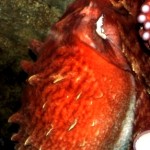
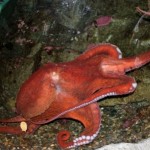
Okay, it’s not everyone’s idea of a cuddly ST Nick, but he is big and he is red and white. Several viewpoints of the Giant Pacific Octopus from the Seattle Aquarium. This fellow stretched out to about ten feet and was in fine form the day I visited. The typical color of a relaxed specimen is the reddish hue seen above. Their easy glide along the ocean floor is supplemented by occasional burst of water jet propulsion.
Our Northwest shoreline is home to one of the most fascinating creatures on God’s earth – the Giant Pacific Octopus. Of the 300 hundred or so species of octopods that inhabit the world’s oceans the biggest of them all is our very own Octopus dofleini (sometimes also Enteroctopus dofleini). Yes, we share the big guy with other shorelines of the North Pacific from California to Asia, but like the great orcas this octopus likes the cold waters of the Northwest.
So how big are they? Despite all the fuss about the size of this octopus, reports of actual measurements vary widely. The largest ever recorded according to the National Geographic Field Guide stretched ten feet from tentacle tip to tentacle tip, but there are reliable reports of 16 feet long, 600 pounds specimens. Some sources claim thirty feet. The disparity is not unexpected. Accurately measuring an animal like this is a difficult task to say the least, and sources don’t always state how the measure was made. Tentacle to tentacle or mantle (head) to tentacle tip? Was the animal dead? Dried in the sun? An exercise like this in the wild is just about impossible. Twenty feet from tentacle tip to tentacle is probably reliable as an average, although there are surely larger specimens out there.
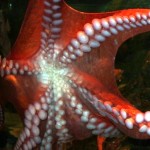
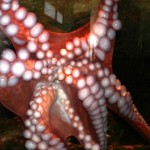
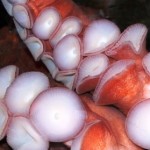
The tentacles and suckers are the key components of survival for any octopus and the Giant Pacific has the record holders.
Whatever the true limits of this creature’s dimensions are it is a remarkable animal by any standard. Imagine the reaction of a diver first confronted with an eight limbed monster three times his size, fins included. That would be an event to remember. And the intrigues don’t stop there. What other animal besides an octopus has three hearts, no internal or external skeleton, a sophisticated brain, complex behaviors, a birdlike beak hidden inside its body, and eyesight to rival any mammal? What other animal can instantly vanish? Or possesses the ability to pour its body like water through the tiniest cracks and crevices? There may be some comic book superhero claiming these talents, but in the real world only an octopus actually possesses such incredible attributes.
Our home grown giant, like all members of the octopus family, belongs to the phylum of animals called Mollusks: clams, oysters, snails, slugs, and squids. Narrowing this down we come to the class called Cephalopods where we find octopus and squids along with cuttlefish and the odd little nautilus, (the only cephalopod, by the way, with a fully developed external shell). Characterized by the biologically popular term of “bilateral symmetry,” cephalopods possess a number of interesting qualities. Of all the invertebrates on earth, and there is an astounding number, the octopus and squids are far and away the most intelligent. They also have unusually keen eyesight, not something normally associated with invertebrates. They are the largest invertebrates, too, and are strictly inhabitants of the ocean. The octopus has now claimed its own order – the appropriately named Octopods.
For the next couple of weeks, however, let’s call them Santapods.

Leave a Reply
You must be logged in to post a comment.